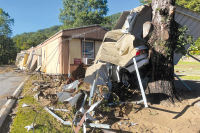Erosion from DOT job concerns Jackson residents
 A highway construction project in Jackson County has come under public scrutiny for muddying the Tuckasegee River.
A highway construction project in Jackson County has come under public scrutiny for muddying the Tuckasegee River.
Erosion control measures have failed to stop mud and sediment from running off the construction site, into creeks and onward to the river during heavy rains. While the highway department has admitted to some runoff problems at the site, it claims it is doing a good job overall.
On three occasions, the Department of Transportation reported itself for violations to state erosion inspectors.
But erosion and sediment watchdogs who have kept tabs on the high-profile roadwork aren’t so sure those were the only three times mud has run off the site.
Roger Clapp, director of the Tuckaseigee Watershed Association, makes a habit of visiting the creek downstream of the construction project after heavy rains to see if there is sediment washing into it, and has noted a brown plume at its confluence with the Tuck.
“Things just aren’t jiving and we need to get data down at the river to find out why it is so muddy at those places,” Clapp said. “I and others know mud is coming off this site.”
Related Items
DOT engineers over the job deflected criticism about its erosion track record for the roadwork during a Jackson County planning board meeting last week.
The county has been fielding complaints about the DOT road construction project, Jackson County Planning Board member Sarah Graham said. But it is unclear who has oversight and who people should call if they notice a problem, she said.
“You fall outside our jurisdiction and we are trying to figure out what we as a planning board can to do address the public’s concerns. Our fresh waterways are a huge part of our quality of life and economy. We want to do what is in our power to fix this,” Graham said.
The project in question is a new road leading to the Southwestern Community College campus off N.C. 107. A controversial project from the outset due to its high cost and questionable need, the new road is being cut over steep terrain, requiring large-scale earthmoving. DOT estimated 500,000 cubic yards of dirt — about 50,000 dump truck loads — will be dug out and hauled off during grading.
Some members of the public claim dirt is falling off the trucks during hauling, either coming out of the tire treads or spilling out the sides.
Jackson County Planning Board Member Gerald Green said he has seen dirt accumulated on the side of the road along the route the dump trucks take when hauling the dirt off.
While that should not be the case, in reality, dirt falls off the trucks sometimes, said Brian Burch, the DOT engineer over the project.
Green asked why it wasn’t cleaned up more quickly, citing one instance when the piles of dropped mud lay along the roadside all weekend.
“Obviously someone didn’t take corrective action,” Burch replied.
“What should be done?” Green asked.
“On the weekend?” Burch asked.
“Anytime,” Green said.
Figuring out who the public should report concerns to — or where to turn for recourse if they weren’t fixed — wasn’t an easy matter, however. Planning board members had to drill down for an answer.
Planning Board member Tom Rodgers eventually suggested the DOT post a prominent sign with a number the public can call if they see a problem.
“I think that would be a good thing to do. There is obviously some confusion about who has oversight authority,” Rodgers said.
During heavy rains, anyone driving along N.C. 107 can see muddy rivulets running down the denuded face of towering steep slopes in the construction zone. So they call the county.
But the county doesn’t have enforcement authority over sediment coming off DOT jobs, so what should the county tell people when they call? Graham said that was the whole reason the planning board invited the DOT to their meeting.
“We wanted to learn more about how y’all handled that,” Graham said.
When the Tuck runs muddy, the people of Jackson County care, said Graham. It also matters to the economy. The tourism industry — fishing and paddling in particular — rely on clean mountain water. Graham said a local fly fishing guide was forced to take clients fishing in other counties recently when the Tuck was too muddy.
“We are trying to understand what we can do to remedy that problem,” Graham told the DOT officials at the meeting. “When the tuck runs brown, what do you think is causing it?”
“I think it is negligible what we contribute,” Burch replied. “We live here, too, and we want to protect our environment, too.”
A 10-year-storm the norm?
The three documented sediment violations at the construction site were the result of heavy rain overtopping a culvert that is supposed to divert a stream around the construction area. The culvert wasn’t big enough, however, and the creek backed up. It overtopped the culvert and flooded the construction site, carrying sediment back into the creek as the water resided, Burch explained.
He blamed extremely heavy rain that exceeded their expectations. Erosion control measures are designed to withstand a certain amount of rainfall, but in these cases, the rainfall exceeded the DOT’s design threshold for a 10-year storm event.
But upon further questioning, Burch said he actually had no way of knowing for sure whether the rainfall exceeded the 10-year-storm standard, but he “assumed” it must have.
Since the erosion control measures are supposed to hold up to run-of-the-mill heavy rains, the fact they didn’t work must mean the rainfall exceeded the 10-year-storm threshold, he said.
“What are the chances of three 10-year-storm events happening in one year,” asked Roger Clapp, the director of the Tuckaseigee Watershed Association. “It is one out of 1,000. We picked the wrong year to do this project.”
Ken Brown, an environmental advocate in the county, said the DOT should reassess the design standard for its erosion control measures if the 10-year-storm threshold isn’t cutting it.
“We seem to have an awful lot of 10-year- storm events,” Brown said.
The state relies on the honor system when it comes to DOT, which self-polices its own erosion compliance, from start to finish.
The DOT develops its own erosion control plan before work begins, signs off on it own plan, makes sure erosion control measures follow the plan, monitors the site for erosion once construction starts, recommends fixes if erosion is noticed, and ultimately report itself for any violations of state sediment laws.
“I think you need someone to inspect it a little more careful and more often,” Planning Board member David Books said.









